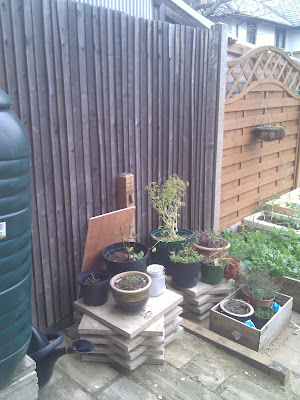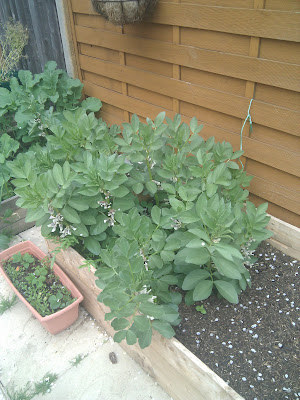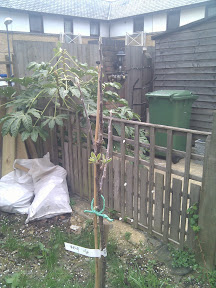I took advantage of a brief sunny period mid-week to go out and rearrange the herb patch.
Sadly I don’t have a very good before photo, but this one from this time last year is a reasonable representation:

This is what it looks like now:

Left to right: strawberry tower (transplanted the strawberries this morning); slab stack with empty pot (for basil), oregano, 2 lavender cuttings, empty pot, another lower empty pot, & a big pot of sage; bay tree at the back; another slab stack with parsley, chives, empty pot, and mint lower down; and a thyme trough at the front.
I moved the concrete slabs very slightly so they’re right back against the fence, and reorientated a couple of lower ones to provide an extra ledge for a plant pot, to make more use of the vertical space. I also repotted the oregano and bay into bigger pots, and the thyme into a shallow trough. I’ve since added a few more empty pots, for a total of 9.
My wanted herb list is:
- Basil (lots)
- Oregano (lots — will take a couple of root divisions now it’s in that larger pot, although this is not the ideal time for that)
- Thyme (want another couple of plants)
- Sage (will take cutting in the spring to fill up that big pot)
- Chives
- Winter savoury
- Mint — will probably take cuttings for another pot to go at the other side of the patio, as well
- Parsley (lots, which is fine as it has self-seeded EVERYWHERE)
- Coriander
- Dill
- Strawberries (OK, not actually a herb)
- Bay
- Rosemary — over the other side of the garden, in the ground
- Lavender — also planted on the other side, in the ground
With nine empty pots to fill, I make that: basil x 2, another oregano, possibly another parsley, dill x 1, winter savoury x 2 (it’s hard to buy), coriander x 1, and one spare pot in case something else takes my fancy. I’m tempted to try ginger, although it’s not cold-hardy. Any other culinary herbs you think I’m missing out on?













